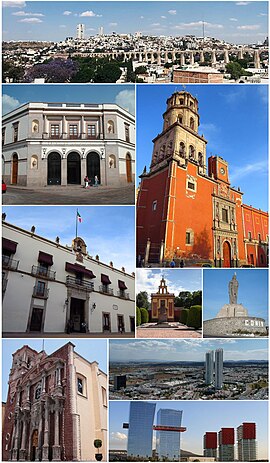Santiago de Querétaro |
|---|
|
 From top to bottom, from left to right: Panoramic view of the Aqueduct of Querétaro, Theater of the Republic, Casa de la Corregidora, Temple of San Francisco de Asís, in the historic center, Chapel of Maximiliano de Habsburgo on Cerro de las Campanas , Conín Statue, Querétaro Cathedral, the Juriquilla area and the Central Park complex. |
 Coat of arms |
| Coordinates: 20°35′15″N 100°23′34″W / 20.58750°N 100.39278°W / 20.58750; -100.39278 |
| Country | Mexico |
|---|
| State | Querétaro |
|---|
| Established | 25 July 1531 |
|---|
| Municipal Status | 1917 |
|---|
|
| • Municipal President | Luis Nava |
|---|
| Elevation | 1,820 m (5,970 ft) |
|---|
|
| • Metro | 1,594,212 |
|---|
| • City | 794,789 |
|---|
| • Municipality | 1,049,777 |
|---|
| Time zone | UTC−6 (CST) |
|---|
| • Summer (DST) | UTC−5 (CDT) |
|---|
| Area codes | 442/446 |
|---|
| Website | queretaro.gob.mx |
|---|
Santiago de Querétaro (Spanish pronunciation: [sanˈtjaɣo ðe keˈɾetaɾo]; Otomi: Dähnini Maxei), known simply as Querétaro City (Spanish: Ciudad de Querétaro), is the capital and largest city of the state of Querétaro. It is located in central Mexico. It is part of the macroregion of Bajío.[2] It is 213 kilometers (132 mi) northwest of Mexico City.
Etymology
The name comes from Purépecha and means "place of great city", named Kehr'iretarhu, although both the town and municipality are commonly referred to as simply "Querétaro".
Maxei in Otomi language and Tlachco in Nahua language.
References